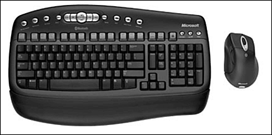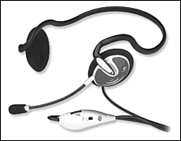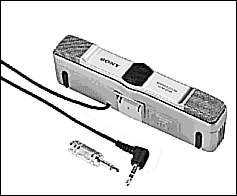Input Devices
| The Tablet PC platform by nature begs for external input devices. If you don't want to attach a keyboard to your slate, you probably want a mouse or a headset for easier input. This section covers the main input devices for the Tablet PC, and provides suggestions for how to get the most out of each device. KeyboardsUnless you have a docking station that supports a PS/2 keyboard, the USB keyboard is your only choice for a wired connection. Fortunately, there are myriad options for USB keyboards. If you have Bluetooth capability, you can use a Bluetooth-enabled keyboard, such as the Microsoft Bluetooth keyboard. What to Look ForThe main thing to look for is a keyboard that works with your Tablet PC. Chances are you'll be looking for a USB keyboard, so that will narrow your options considerably. After you've hammered out the interface issue (that is, whether the keyboard should be USB, PS/2, or Bluetooth), you will want to look at the keyboard layout. Keyboards can be straight, curved, tilted, and flat. Most keyboards have standard-size keys, but some will be smaller to save space. Once you've determined what style of keyboard feels best to you, narrow down the options by examining the various keyboards' extra features. If you don't need any, go for the basic model that feels good to you. Otherwise, identify which of the many keyboard add-ons you want: scroll wheels, surf buttons, application buttons, pointing devices, and programmable buttons.
MiceUSB mice are your only options for wired connections unless you have a PS/2-capable port replicator. There are many types and brands. I recommend the Logitech Wheel Mouse, which isoptical and has a scroll wheel. The optical aspect of the mouse provides superior tracking on all but reflective surfaces (glass or high-gloss). Optical mice do not have the problems of dirty tracking balls and are better for travel because they work on most surfaces. I don't even use a mouse pad with my mouse in most places. If you happen to have a glossy surface and no mouse pad, just use a piece of paper or a low-gloss magazine. Another option is the Bluetooth mouse. If your Tablet PC is set up to use Bluetooth, a mouse like Microsoft's Bluetooth mouse can be useful because it requires no wires. What to Look ForOptical is the way to go for most users. Optical mice track well, and don't require cleaning. They can also operate on a sheet of paper or magazine. Wired mice are usually okay, but wireless mice have the benefits of reducing wire tangles.
Upgraded PensThe pens that are available to you depend on the Tablet PC you use. If you use a Wacom-based Tablet PC, you will have more options than with other systems. Wacom and Cross, for example, are coming out with executive-style pens that look more like traditional high-end pens. Because Tablet PCs like the Compaq use a battery-operated pen, the barrel cannot be much thinner than the one that comes with the tablet, which limits the ergonomics of potential pens. Check with your Tablet PC manufacturer to find out what pens can be used with your Tablet PC. If you have a Wacom-based digitizer in your Tablet PC, you can go to Wacom's site (www.wacom.com) to find some additional pens. What to Look ForLook for a pen that feels good in your hand and that also has the features you want. Some come with eraser tips on the back end (just like a pencil), and some come with switches on the barrel for right-tapping or assigning other functions. A good pen will let you work naturally. HeadsetsHeadsets are kind of like headphones, except with a microphone. Headsets are usually the preferred way to speak to your computer, because they provide a close microphone and greater clarity of input. When you look for a headset, you want to find one that is noise canceling, which means it disregards extraneous noise when you talk. This will give you the most accurate voice recognition. There are many types of headsets, and unfortunately, many are incompatible with computers. Most are made for telephones, and are not readily compatible with the PC interface. You can get adapters for the ones that use the mini jack for cell phones, but the headsets made for stationary telephone sets are usually incompatible. That said, you can find various types of headsets for use with your Tablet PC ones that enclose your ears, that sit on your ears, that clip around one ear, and that wrap around your head. I used the Logitech Internet Chat Headset and the Plantronics DSP-400 headset while I wrote this book and dictated chapters; I have included details about each in the following sidebars. What to Look ForFind a headset that is noise-canceling. That's the most important aspect of the microphone. It will eliminate surrounding noise. Other than noise cancellation, the headphones should be comfortable, lightweight, and offer the audio performance you require. If you want a stereo headset, make sure you get one with two earcups or earpads that provide stereo sound. Otherwise, there are many headsets that provide monaural (mono) audio playback in a single ear, which may be sufficient for you. Typically, the more padded the headset, the more comfortable it will be, but always try it on and think of how it will feel in a two-hour dictation session. If there's anything that bugs you about it when you first try it on, go to another headset. It's not worth being uncomfortable, because you won't use it as much if it is.
MicrophonesMicrophones are similar to headsets in that they provide for voice input. However, they are usually stand-alone, and don't connect to your head. Most microphones for computers sit on a desk or attach to a monitor. What to Look ForIf you're looking for a microphone for speech recognition, it should be of the noise-canceling variety.
|
EAN: 2147483647
Pages: 172




